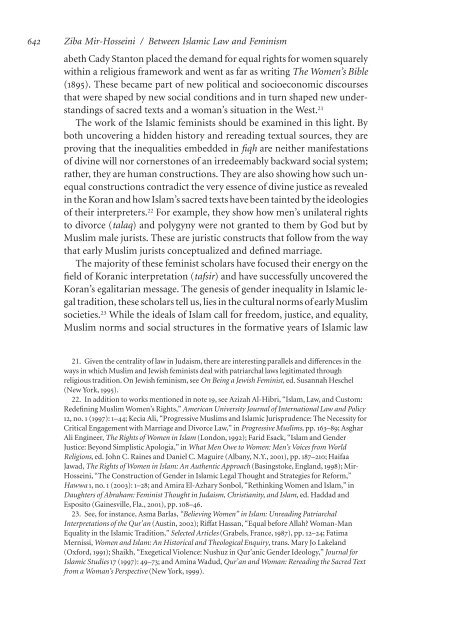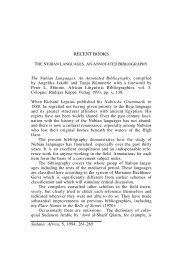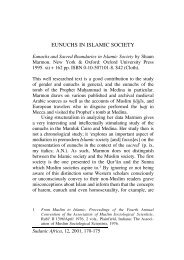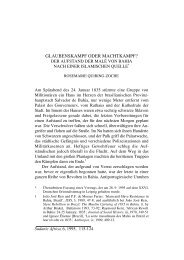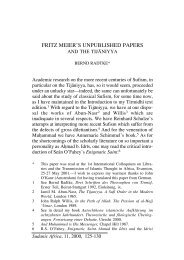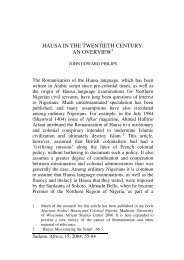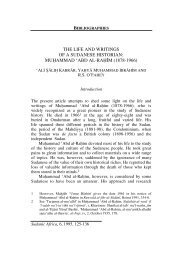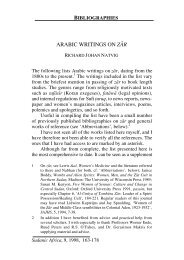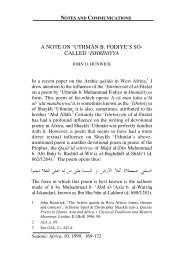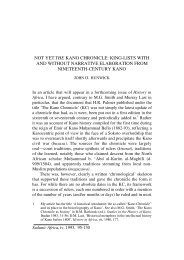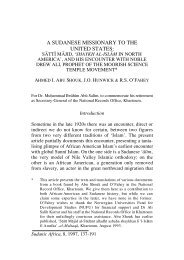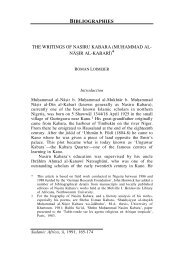Muslim Women's Quest for Equality: Between Islamic Law and ...
Muslim Women's Quest for Equality: Between Islamic Law and ...
Muslim Women's Quest for Equality: Between Islamic Law and ...
You also want an ePaper? Increase the reach of your titles
YUMPU automatically turns print PDFs into web optimized ePapers that Google loves.
642 Ziba Mir-Hosseini / <strong>Between</strong> <strong>Islamic</strong> <strong>Law</strong> <strong>and</strong> Feminismabeth Cady Stanton placed the dem<strong>and</strong> <strong>for</strong> equal rights <strong>for</strong> women squarelywithin a religious framework <strong>and</strong> went as far as writing The Women’s Bible(1895). These became part of new political <strong>and</strong> socioeconomic discoursesthat were shaped by new social conditions <strong>and</strong> in turn shaped new underst<strong>and</strong>ingsof sacred texts <strong>and</strong> a woman’s situation in the West. 21The work of the <strong>Islamic</strong> feminists should be examined in this light. Byboth uncovering a hidden history <strong>and</strong> rereading textual sources, they areproving that the inequalities embedded in fiqh are neither manifestationsof divine will nor cornerstones of an irredeemably backward social system;rather, they are human constructions. They are also showing how such unequalconstructions contradict the very essence of divine justice as revealedin the Koran <strong>and</strong> how Islam’s sacred texts have been taintedbytheideologiesof their interpreters. 22 For example, they show how men’s unilateral rightsto divorce (talaq) <strong>and</strong> polygyny were not granted to them by God but by<strong>Muslim</strong> male jurists. These are juristic constructs that follow from the waythat early <strong>Muslim</strong> jurists conceptualized <strong>and</strong> defined marriage.The majority of these feminist scholars have focused their energy on thefield of Koranic interpretation (tafsir) <strong>and</strong> have successfully uncovered theKoran’s egalitarian message. The genesis of gender inequality in <strong>Islamic</strong> legaltradition, these scholars tell us, lies in the cultural norms of early<strong>Muslim</strong>societies. 23 While the ideals of Islam call <strong>for</strong> freedom, justice, <strong>and</strong> equality,<strong>Muslim</strong> norms <strong>and</strong> social structures in the <strong>for</strong>mative years of <strong>Islamic</strong> law21. Given the centrality of law in Judaism, there are interesting parallels <strong>and</strong> differences in theways in which <strong>Muslim</strong> <strong>and</strong> Jewish feminists deal with patriarchal laws legitimated throughreligious tradition. On Jewish feminism, see On Being a Jewish Feminist, ed. Susannah Heschel(New York, 1995).22. In addition to works mentioned in note 19, see Azizah Al-Hibri, “Islam, <strong>Law</strong>, <strong>and</strong> Custom:Redefining <strong>Muslim</strong> Women’s Rights,” American University Journal of International <strong>Law</strong> <strong>and</strong> Policy12, no. 1 (1997): 1–44; Kecia Ali, “Progressive <strong>Muslim</strong>s <strong>and</strong> <strong>Islamic</strong> Jurisprudence: The Necessity <strong>for</strong>Critical Engagement with Marriage <strong>and</strong> Divorce <strong>Law</strong>,” in Progressive <strong>Muslim</strong>s, pp. 163–89; AsgharAli Engineer, The Rights of Women in Islam (London, 1992); Farid Esack, “Islam <strong>and</strong> GenderJustice: Beyond Simplistic Apologia,” in What Men Owe to Women: Men’s Voices from WorldReligions, ed. John C. Raines <strong>and</strong> Daniel C. Maguire (Albany, N.Y., 2001), pp. 187–210; HaifaaJawad, The Rights of Women in Islam: An Authentic Approach (Basingstoke, Engl<strong>and</strong>, 1998); Mir-Hosseini, “The Construction of Gender in <strong>Islamic</strong> Legal Thought <strong>and</strong> Strategies <strong>for</strong> Re<strong>for</strong>m,”Hawwa 1, no. 1 (2003): 1–28; <strong>and</strong> Amira El-Azhary Sonbol, “Rethinking Women <strong>and</strong> Islam,” inDaughters of Abraham: Feminist Thought in Judaism, Christianity, <strong>and</strong> Islam, ed. Haddad <strong>and</strong>Esposito (Gainesville, Fla., 2001), pp. 108–46.23. See, <strong>for</strong> instance, Asma Barlas, “Believing Women” in Islam: Unreading PatriarchalInterpretations of the Qur’an (Austin, 2002); Riffat Hassan, “Equal be<strong>for</strong>e Allah? Woman-Man<strong>Equality</strong> in the <strong>Islamic</strong> Tradition,” Selected Articles (Grabels, France, 1987), pp. 12–24; FatimaMernissi, Women <strong>and</strong> Islam: An Historical <strong>and</strong> Theological Enquiry, trans. Mary Jo Lakel<strong>and</strong>(Ox<strong>for</strong>d, 1991); Shaikh, “Exegetical Violence: Nushuz in Qur’anic Gender Ideology,” Journal <strong>for</strong><strong>Islamic</strong> Studies 17 (1997): 49–73; <strong>and</strong> Amina Wadud, Qur’an <strong>and</strong> Woman: Rereading the Sacred Textfrom a Woman’s Perspective (New York, 1999).


